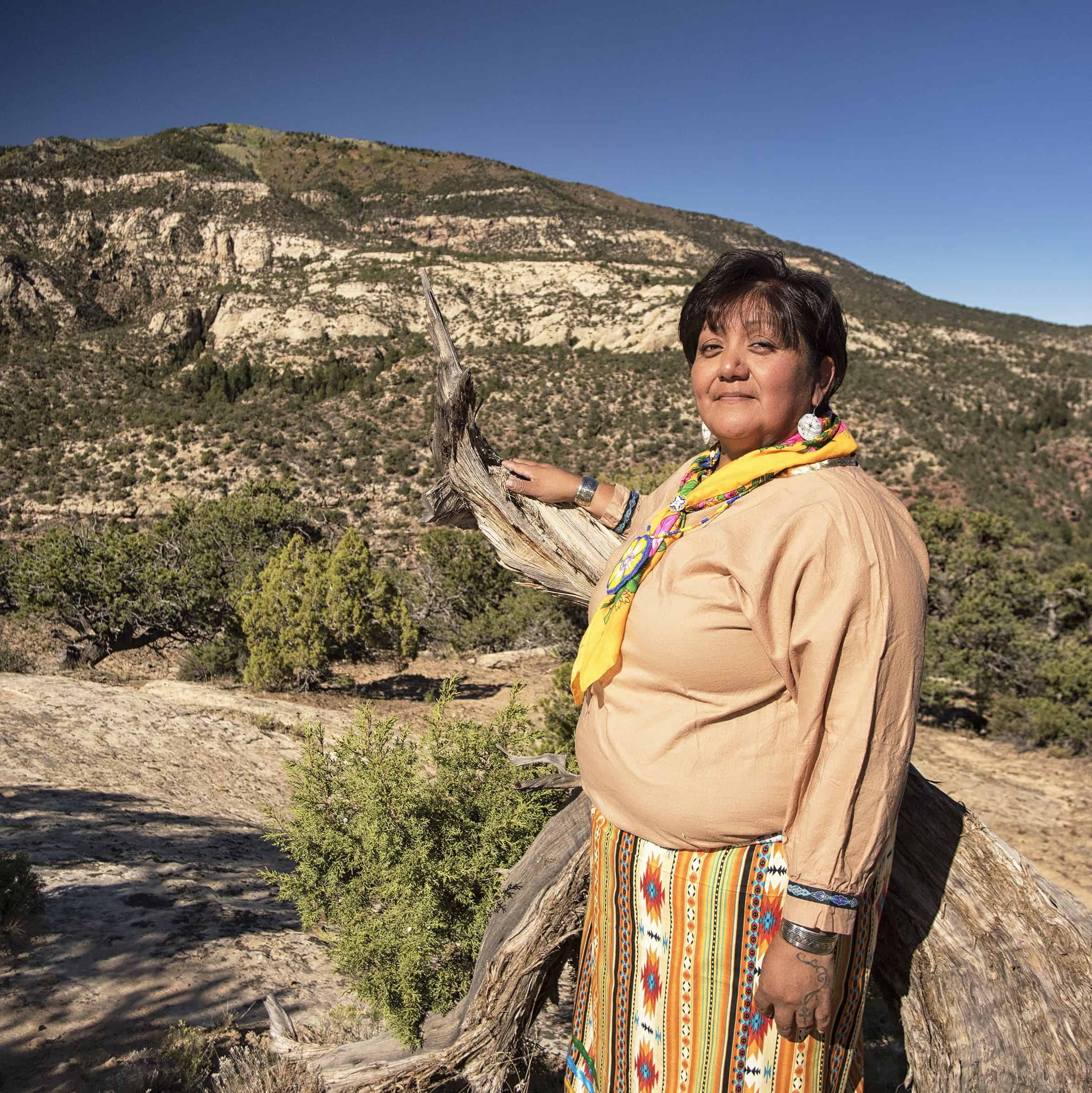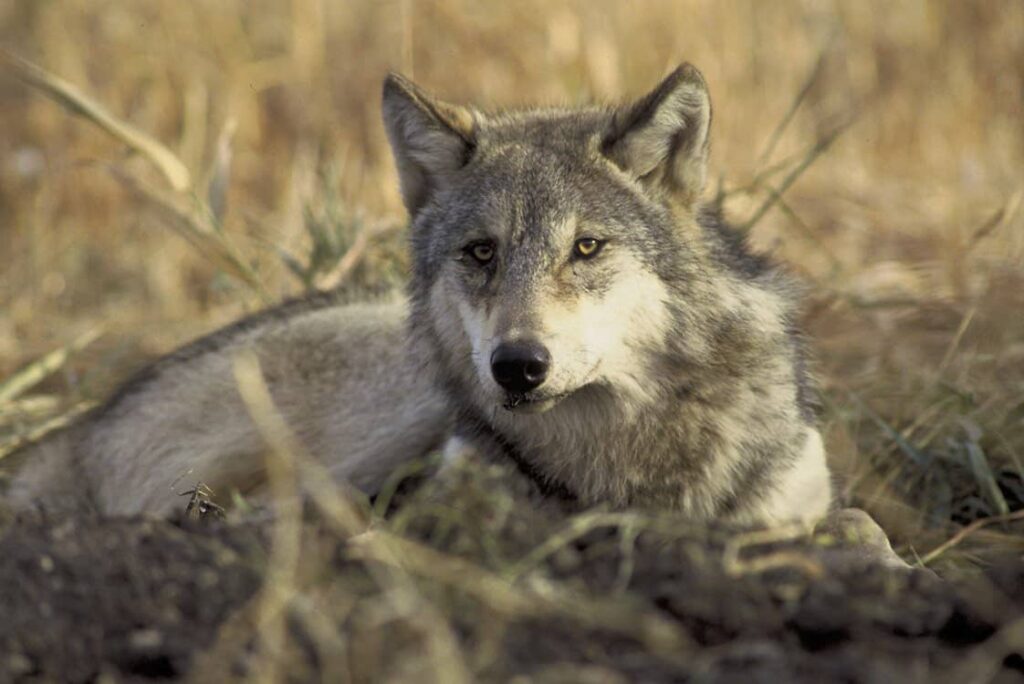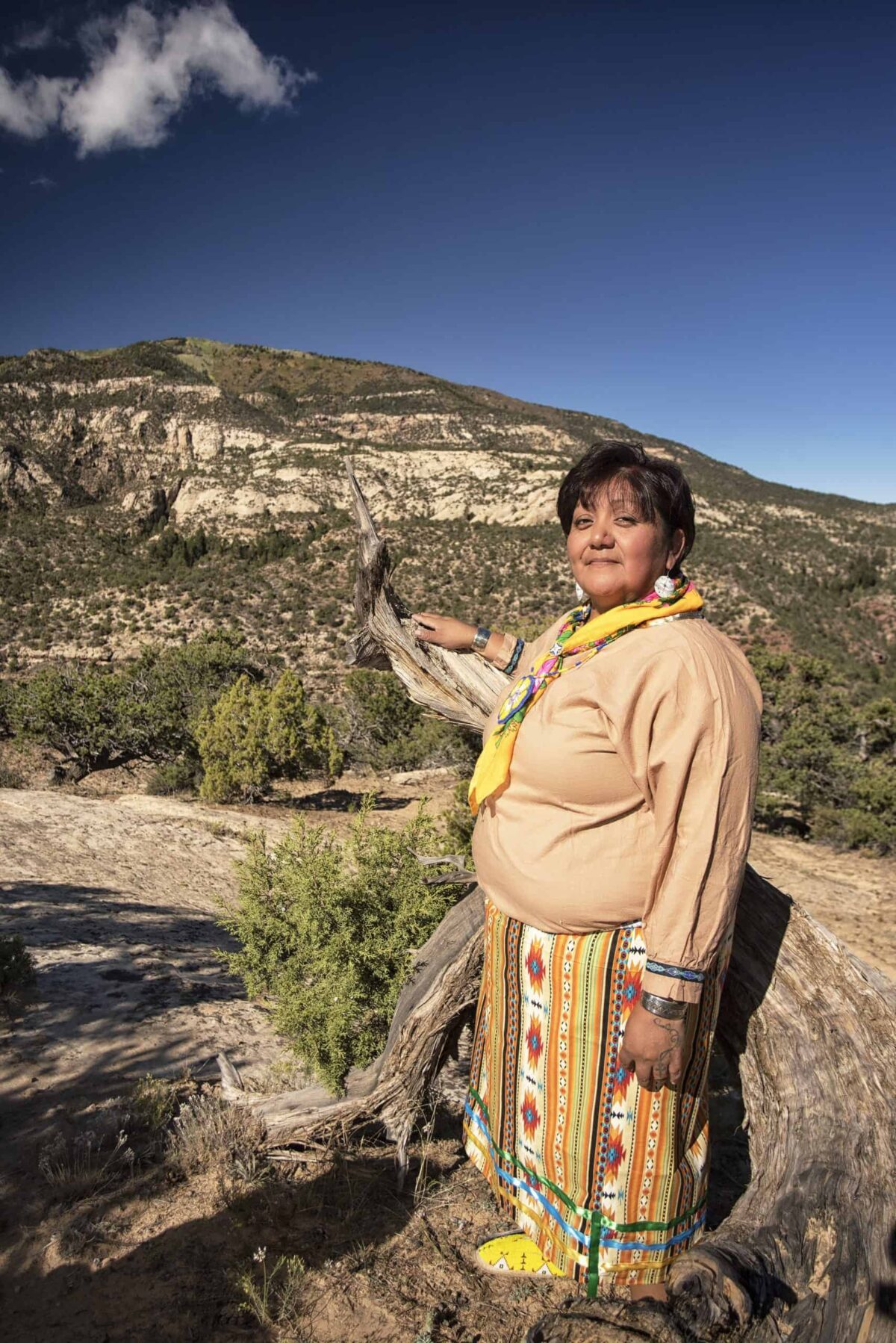Lopez-Whiteskunk discusses the cultural and ecological importance of wolves, the need to seek out and include Indigenous perspectives, and the reasons some tribes are split on wolf reintroduction.

“I think we as human beings need to stop and think about what we’re doing — what are we doing that will put our children, grandchildren, and future generations in this same predicament we have right now, having these same difficult conversations,“ says Regina Lopez-Whiteskunk, a Ute Mountain Ute tribal member, and a leader within the tribal and conservation communities.
Nowadays, Lopez-Whiteskunk works for the Montezuma Land Conservancy in a role as cross culture program manager. In that position, she’s currently working on a tribal traditional harvesting plan in coordination with the Ute Mountain Ute Tribe as part of her required Master’s in Environmental Management (MEM) graduate project at Western.
Previously, Lopez-Whiteskunk was an elected leader on the Ute Mountain Ute’s tribal council, and served as a representative for the Ute Mountain Ute on the Bears Ears Inter-Tribal Coalition, a landmark organization that advocated for, and attained, the designation of Bears Ears National Monument under the Obama Administration.
Bringing together the Hopi Tribe, the Navajo Nation, the Ute Mountain Ute Tribe, the Pueblo of Zuni, and the Ute Indian Tribe, the Inter-Tribal Coalition led the monument campaign which led to Obama’s 2016 proclamation that protected more than 1.3 million acres of lands held sacred to all five involved tribes.
Following President Trump’s 2017 shrinkage of the monument, which decreased the protected acreage by 85 percent, the Biden Administration restored and expanded Bears Ears National Monument to its current status of 1.9 million acres.
Today, Lopez-Whiteskunk serves as one of 15 designated members on the Monument Advisory Committee, or MAC (and one of three representing tribal interests), which provides input to federal land managers to make decisions on the ground.
Lopez-Whiteskunk was kind enough to speak with Top o’ the World about wolf reintroduction, and how we can learn from the mistakes of the past to make wiser decisions moving forward.
The cultural importance of wolves to Native peoples
Across many different tribes and diverse landscapes — from Alaska to the Great Plains — wolves have played an important role in the stories and ceremonies that shape how Native peoples view the natural world.
In Indigenous cultures across the continent, gray wolves symbolize courage, success, and strength.
“In our stories, that being was a very strong individual,” adds Lopez-Whiteskunk. “It didn’t represent anything bad.”
She draws a clear distinction between the wolf and the coyote, with the latter often symbolizing trickery and challenges to humans. The mere presence of the wolf on the landscape, Lopez-Whiteskunk notes, helps to keep coyote populations in check.
For several centuries in modern, white-dominated American culture, particularly in heavy agricultural areas, the wolf has been assigned an adversarial role. The wolf is seen as an aggressor and is associated with the dark, deeply unfriendly wilderness, and with the destruction of life and property. The wolf is something to fear, and something to banish from the landscape — perhaps even an outright evil being.
But in the eyes of many Native peoples, the wolf’s strong devotion to family stood out, and drew parallels between close-knit tribal members and members of a wolf pack, who intimately depended on each other for survival.
The Pawnee, whose historic range spanned what is now known as Kansas and Nebraska, felt such kinship with the wolves that their hand signal for the predators was the same as their signal for Pawnee. To neighboring tribes, the Pawnee were known as wolves.
That comparison is a point of pride for the Pawnee to this day, and represents the cunning and courage of their people.
Intertwined with this cultural importance is the important role that wolves assume within ecosystems, which has long been recognized by Indigenous peoples.
“The caribou feeds the wolf, but it is the wolf who keeps the caribou strong,” says one proverb, attributed to the Keewation Inuit people, which reflects a holistic, ecological view of the world.
In a similar vein, Lopez-Whiteskunk sees all forms of life on Earth as being part of a larger, interconnected system.
“My grandpa used to speak to every being, every insect, every piece of life here as having its place,” she says. “When you respect life, [that respect] gets returned back to you.”

Planning for wolves in Colorado
On the bureaucratic side of things, CPW’s draft plan includes a 60-mile buffer with neighboring states where wolves will not be released. That buffer also applies to Native American reservations, two of which fall within Colorado’s border: the Southern Ute and the Ute Mountain Ute.
From the agency’s draft plan: “Releases in Colorado will be located a minimum of 60 miles from the northern border with Wyoming, the western border with Utah, the southern border of New Mexico, as well as a similar buffer, as requested by the Tribes, of sovereign tribal lands in southwestern Colorado.”
While the wolves won’t initially be released in the corners of the state, there will be nothing keeping them from migrating south from Colorado’s western mountains towards the tribal reservations — and throughout the greater Four Corners region.
In the past three decades, wolves have disseminated from the Yellowstone Valley throughout Wyoming and Idaho — pushing southward into Colorado and reproducing.
The prospect of further wolf presence in Colorado has divided some members of tribal nations in the southwest, and here in Colorado.
The Southern Ute Indian Tribal Council, led by the tribe’s Wildlife Advisory Board, came out in opposition to the wolf reintroduction ballot initiative back in the summer of 2020.
The council cited concerns that the predator would adversely impact other wildlife populations via predation, primarily elk and moose, as well as local livestock populations — both on and off the tribal reservation.
There are also concerns about wolves potentially transmitting the hydatid, a tapeworm parasite which can impact both wild and domestic animals.
In making their decision to oppose wolf reintroduction, Southern Ute leadership also pointed to the Northern Ute and the Navajo, two tribes which have passed their own resolutions opposing wolf reintroduction.
The Southern Ute’s official position, expressed in the summer of 2020, is that wolves should be allowed to migrate southward naturally from the northern Rockies, but should not be reintroduced by the government.
Some within the tribe offer a distinctly different view, including Southern Ute elder Pearl Casias:
“We know from our ancestors that each animal that co-existed with us had their purpose too, which came down through stories and some of the legends. The wolves and the cougars and other meat-eating creatures helped sustain the ecosystem. They each had their purpose, as did all creatures that were created to roam this earth beside the two-legged people. [For the] two-legged, it was innate to take what you need, to not do trophy hunting, and things of that nature.”
Lopez-Whiteskunk says she can see a clear dividing line in her Ute Mountain Ute community between those who own livestock, who often occupy roles of power within tribes, and those who do not.
“I don’t have a livestock interest, but I do have an interest in our ecological system, and I do have a lot of the traditional guiding principles that I was raised with,” says Lopez-Whiteskunk. “My grandmother always spoke of when the animals and the Ute spoke the same language.”
In her eyes, the conversations that are being had, and that have been had the last three years around wolf reintroduction, display an underlying issue with the modern way of life. In today’s world, traditional knowledge has often been set aside in favor of political and economic aims.
“When we get into conversations like this, it just represents the true disconnect, and the separation, and [shows] how far away we are from our original teachings and upbringings — and how far away [we are] from living a good, honorable, humble life,” she expands.
The Global Indigenous Council (GIC), an international body that advocates on behalf of First Nations internationally, supported wolf reintroduction in Colorado, citing the GIC’s Wolf Treaty.
The Wolf Treaty pushes back against the linked, ongoing destruction of the intertwined environmental and cultural worlds held as sacred by Indigenous peoples, and advocates for enhanced protections for wolves.
“To honor, recognize, and revitalize the ancient relationship we have with the wolf, it is the collective intention of we, the undersigned, to welcome the wolf to once again live beside us as Creator intended and to restore balance to Mother Earth where we are the stewards and the wolf is a protector of our lands,” reads a portion of the treaty’s text.
“After 243-years, this pattern of greed and deceit must end. This Wolf Treaty is our red line. It should become the red line for all who want to save Endangered and Threatened species,” said GIC’s then-acting president Tom Rodgers.
From her vantage, Lopez-Whiteskunk says that restoring the Earth’s balance will mean letting natural processes take the reigns — and reconciling with the fact that humans had pushed wolves to the brink of extirpation in much of the American West just a couple decades ago.
“If we had enough respect for that being and its place in our world and our ecosystems, we wouldn’t be here,” she says of the current wolf reintroduction efforts, which she supports.
For Lopez-Whiteskunk, relearning traditional knowledge and incorporating deep-rooted cultural values into modern decision-making can serve as a check on humanity’s hubris, which has plunged the Earth into ecological crisis.
In many cases, the damage inflicted to the natural world requires significant effort to undo, including the lengthy, turbulent process of wolf reintroduction, which has proven unpopular with many.
“As Indigenous people, we’ve understood that there are some things we control, and there are some things we don’t control, even with the best of [human] engineering and intentions,” she adds.
Moving towards meaningful collaboration with tribes
As it stands, CPW’s draft plan makes several brief mentions of consultation with Native groups regarding impacts of wolf reintroduction on livestock and other logistical concerns.
However, the current draft plan demonstrates little firm planning until this point — beyond boilerplate, generalized language — signaling that CPW will undergo meaningful consultation with Colorado’s Indigenous populations.
“[The Stakeholder Advisory Group] also includes representation from the Southern Ute Tribe; however, this representation is not a substitute for government-to-government consultation,” reads the agency’s draft plan, acknowledging the need to go further in consulting tribes on wolf reintroduction.
In one short section on managing wolf impacts, the plan reads: “CPW, in partnership with Tribes in the case of conflicts arising on the sovereign lands of Tribal nations, will work with livestock owners to investigate, assess the situation, and take appropriate action.”
There is some other loose, generalized language in the plan about collaboration and cooperation with tribal governments, law enforcement, and ranchers, but the current plan is fairly light on details.
Lopez-Whiteskunk says that government-to-government outreach and collaboration from CPW’s leadership to Southern Ute and Ute Mountain Ute tribal leaders is important, but that if the state agency is serious about obtaining input from Native communities, they should seek out direct conversations with members of the community, who may offer traditional perspectives steeped in Native beliefs and values.
“Our tribal officials aren’t exactly conveying what some of us believe traditionally, culturally. I would challenge members of CPW to leave their offices and come into the tribal communities and talk to the regular Joe-Schmo, or even have a listening session inside the tribal communities and see who comes out to talk to them,” she says.
Regina notes that public engagement meetings are often held in locations that are inconvenient, if not impossible, for Native people to make their voices heard.
During CPW’s listening session tour of Colorado, the agency’s Commission visited Gunnison, Colorado Springs, Rifle, and Denver, with one meeting held virtually.
Gunnison, the closest physical location to the Ute Mountain Ute reservation in the recent CPW meeting slate, is more than four hours and 200 miles away — an insurmountable barrier for many in the community.
Lopez-Whiteskunk adds that online meetings and comment forums are notoriously difficult to get Native communities to engage with.
“Trying to get tribal communities to provide public comment electronically — it just doesn’t happen. You really have to pound the pavement to get a genuine contribution of what [Native] people are thinking,” she said.

